IKEA: Business Environment Analysis, PESTEL, SWOT and Macro Factors
VerifiedAdded on 2020/10/05
|10
|2825
|435
Report
AI Summary
This report provides a comprehensive analysis of IKEA's business operations within its environment. It begins by outlining the positive and negative impacts of the macro environment, such as political stability, economic fluctuations, and socio-cultural factors, on IKEA's performance. The report then delves into an internal and external analysis of IKEA using the PESTEL framework, examining political, economic, social, technological, environmental, and legal factors. A SWOT analysis is also conducted to identify IKEA's strengths, weaknesses, opportunities, and threats, highlighting how these factors interrelate with the external macro environment. The report emphasizes the importance of adapting to changing social values, technological advancements, and environmental concerns, and how IKEA addresses these challenges in its global operations.

Business and the Business
Environment
Environment
Paraphrase This Document
Need a fresh take? Get an instant paraphrase of this document with our AI Paraphraser
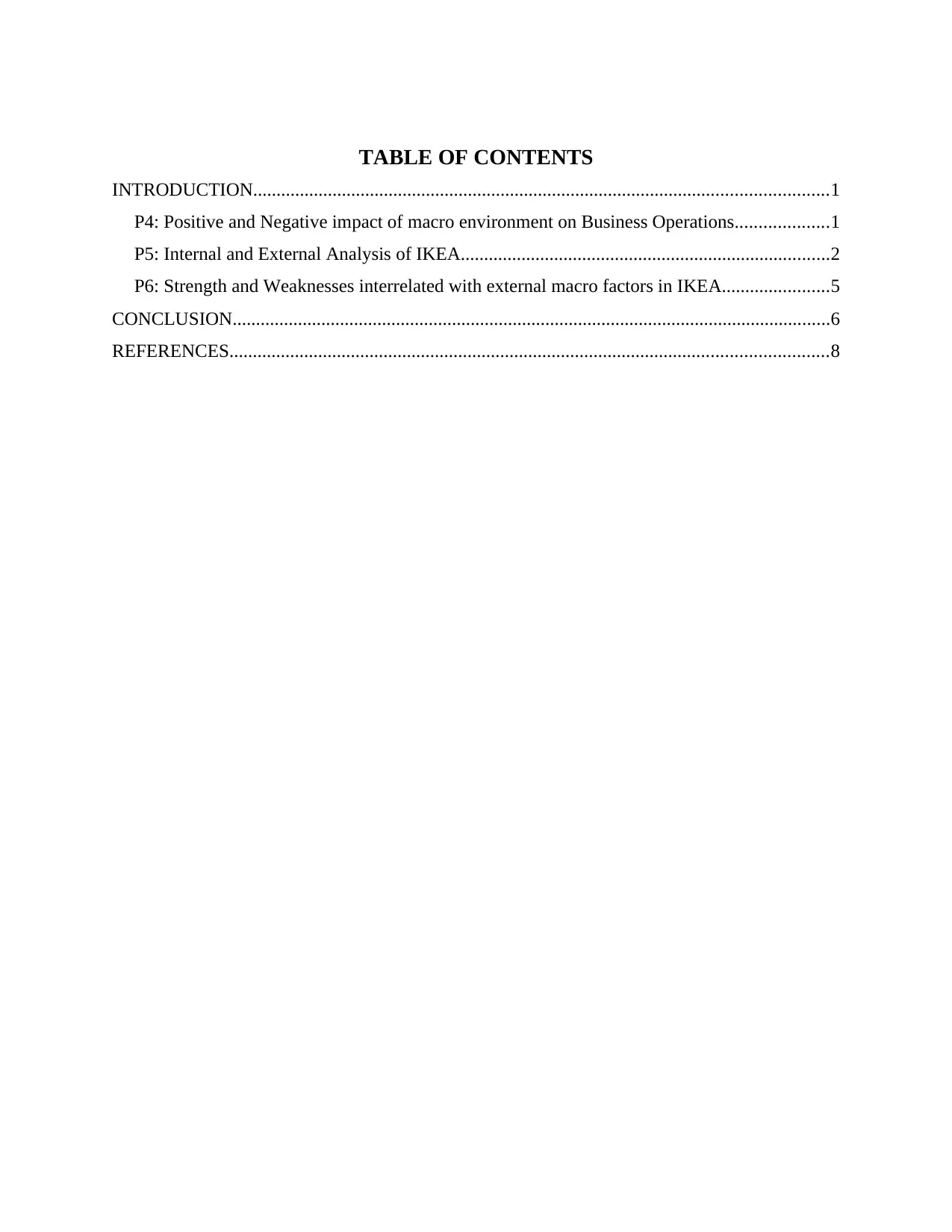
TABLE OF CONTENTS
INTRODUCTION...........................................................................................................................1
P4: Positive and Negative impact of macro environment on Business Operations....................1
P5: Internal and External Analysis of IKEA...............................................................................2
P6: Strength and Weaknesses interrelated with external macro factors in IKEA.......................5
CONCLUSION................................................................................................................................6
REFERENCES................................................................................................................................8
INTRODUCTION...........................................................................................................................1
P4: Positive and Negative impact of macro environment on Business Operations....................1
P5: Internal and External Analysis of IKEA...............................................................................2
P6: Strength and Weaknesses interrelated with external macro factors in IKEA.......................5
CONCLUSION................................................................................................................................6
REFERENCES................................................................................................................................8
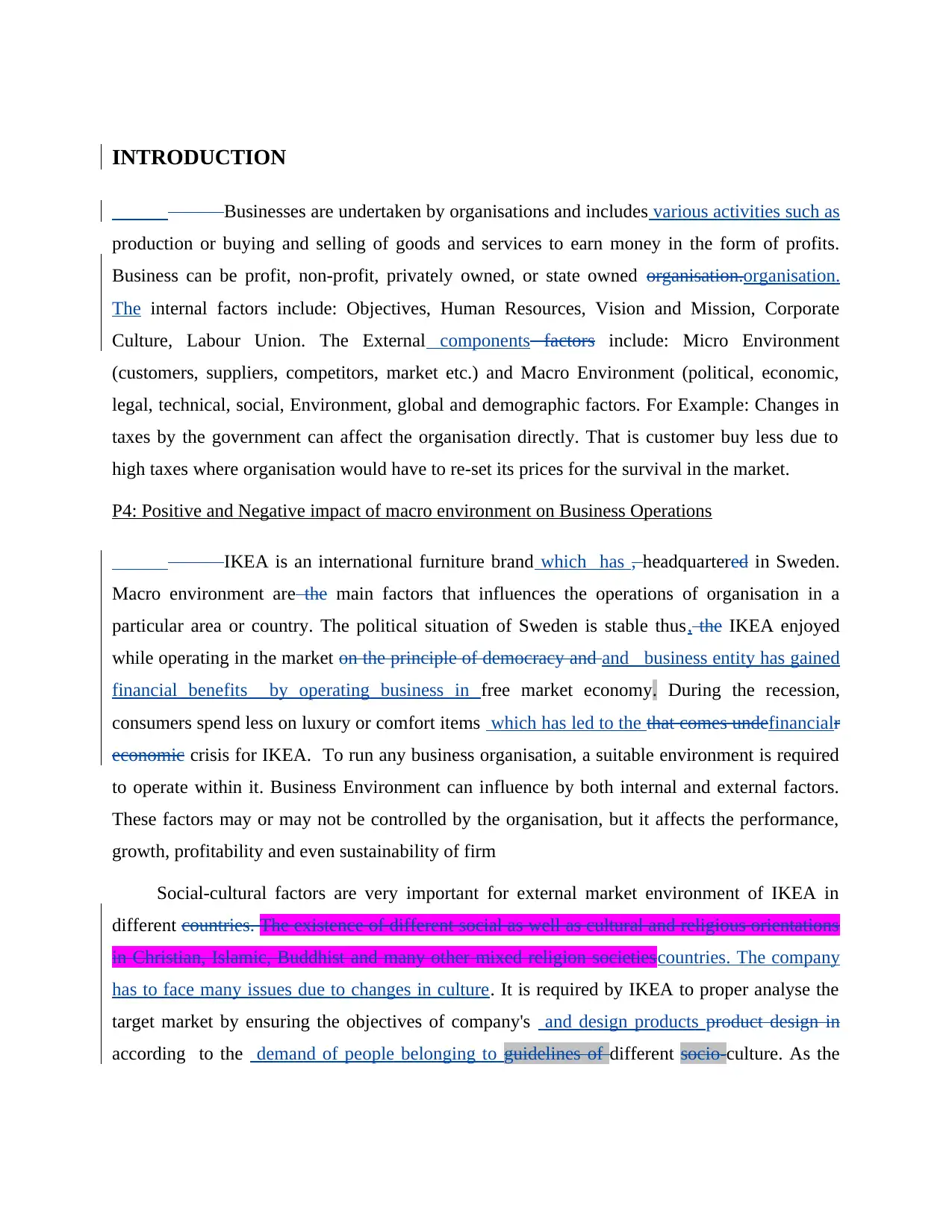
INTRODUCTION
Businesses are undertaken by organisations and includes various activities such as
production or buying and selling of goods and services to earn money in the form of profits.
Business can be profit, non-profit, privately owned, or state owned organisation.organisation.
The internal factors include: Objectives, Human Resources, Vision and Mission, Corporate
Culture, Labour Union. The External components factors include: Micro Environment
(customers, suppliers, competitors, market etc.) and Macro Environment (political, economic,
legal, technical, social, Environment, global and demographic factors. For Example: Changes in
taxes by the government can affect the organisation directly. That is customer buy less due to
high taxes where organisation would have to re-set its prices for the survival in the market.
P4: Positive and Negative impact of macro environment on Business Operations
IKEA is an international furniture brand which has , headquartered in Sweden.
Macro environment are the main factors that influences the operations of organisation in a
particular area or country. The political situation of Sweden is stable thus, the IKEA enjoyed
while operating in the market on the principle of democracy and and business entity has gained
financial benefits by operating business in free market economy. During the recession,
consumers spend less on luxury or comfort items which has led to the that comes undefinancialr
economic crisis for IKEA. To run any business organisation, a suitable environment is required
to operate within it. Business Environment can influence by both internal and external factors.
These factors may or may not be controlled by the organisation, but it affects the performance,
growth, profitability and even sustainability of firm
Social-cultural factors are very important for external market environment of IKEA in
different countries. The existence of different social as well as cultural and religious orientations
in Christian, Islamic, Buddhist and many other mixed religion societiescountries. The company
has to face many issues due to changes in culture. It is required by IKEA to proper analyse the
target market by ensuring the objectives of company's and design products product design in
according to the demand of people belonging to guidelines of different socio-culture. As the
Businesses are undertaken by organisations and includes various activities such as
production or buying and selling of goods and services to earn money in the form of profits.
Business can be profit, non-profit, privately owned, or state owned organisation.organisation.
The internal factors include: Objectives, Human Resources, Vision and Mission, Corporate
Culture, Labour Union. The External components factors include: Micro Environment
(customers, suppliers, competitors, market etc.) and Macro Environment (political, economic,
legal, technical, social, Environment, global and demographic factors. For Example: Changes in
taxes by the government can affect the organisation directly. That is customer buy less due to
high taxes where organisation would have to re-set its prices for the survival in the market.
P4: Positive and Negative impact of macro environment on Business Operations
IKEA is an international furniture brand which has , headquartered in Sweden.
Macro environment are the main factors that influences the operations of organisation in a
particular area or country. The political situation of Sweden is stable thus, the IKEA enjoyed
while operating in the market on the principle of democracy and and business entity has gained
financial benefits by operating business in free market economy. During the recession,
consumers spend less on luxury or comfort items which has led to the that comes undefinancialr
economic crisis for IKEA. To run any business organisation, a suitable environment is required
to operate within it. Business Environment can influence by both internal and external factors.
These factors may or may not be controlled by the organisation, but it affects the performance,
growth, profitability and even sustainability of firm
Social-cultural factors are very important for external market environment of IKEA in
different countries. The existence of different social as well as cultural and religious orientations
in Christian, Islamic, Buddhist and many other mixed religion societiescountries. The company
has to face many issues due to changes in culture. It is required by IKEA to proper analyse the
target market by ensuring the objectives of company's and design products product design in
according to the demand of people belonging to guidelines of different socio-culture. As the
⊘ This is a preview!⊘
Do you want full access?
Subscribe today to unlock all pages.

Trusted by 1+ million students worldwide
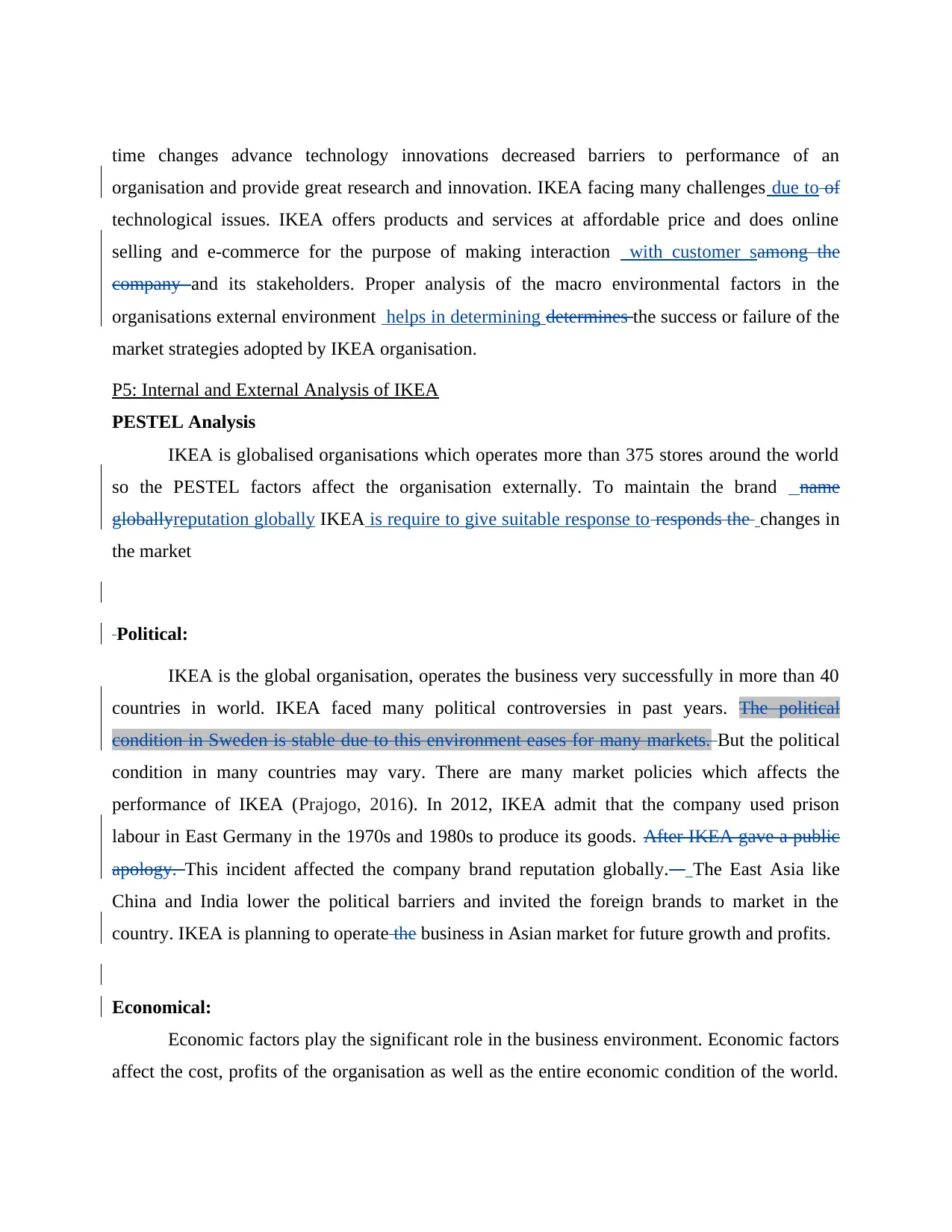
time changes advance technology innovations decreased barriers to performance of an
organisation and provide great research and innovation. IKEA facing many challenges due to of
technological issues. IKEA offers products and services at affordable price and does online
selling and e-commerce for the purpose of making interaction with customer samong the
company and its stakeholders. Proper analysis of the macro environmental factors in the
organisations external environment helps in determining determines the success or failure of the
market strategies adopted by IKEA organisation.
P5: Internal and External Analysis of IKEA
PESTEL Analysis
IKEA is globalised organisations which operates more than 375 stores around the world
so the PESTEL factors affect the organisation externally. To maintain the brand name
globallyreputation globally IKEA is require to give suitable response to responds the changes in
the market
Political:
IKEA is the global organisation, operates the business very successfully in more than 40
countries in world. IKEA faced many political controversies in past years. The political
condition in Sweden is stable due to this environment eases for many markets. But the political
condition in many countries may vary. There are many market policies which affects the
performance of IKEA (Prajogo, 2016). In 2012, IKEA admit that the company used prison
labour in East Germany in the 1970s and 1980s to produce its goods. After IKEA gave a public
apology. This incident affected the company brand reputation globally. The East Asia like
China and India lower the political barriers and invited the foreign brands to market in the
country. IKEA is planning to operate the business in Asian market for future growth and profits.
Economical:
Economic factors play the significant role in the business environment. Economic factors
affect the cost, profits of the organisation as well as the entire economic condition of the world.
organisation and provide great research and innovation. IKEA facing many challenges due to of
technological issues. IKEA offers products and services at affordable price and does online
selling and e-commerce for the purpose of making interaction with customer samong the
company and its stakeholders. Proper analysis of the macro environmental factors in the
organisations external environment helps in determining determines the success or failure of the
market strategies adopted by IKEA organisation.
P5: Internal and External Analysis of IKEA
PESTEL Analysis
IKEA is globalised organisations which operates more than 375 stores around the world
so the PESTEL factors affect the organisation externally. To maintain the brand name
globallyreputation globally IKEA is require to give suitable response to responds the changes in
the market
Political:
IKEA is the global organisation, operates the business very successfully in more than 40
countries in world. IKEA faced many political controversies in past years. The political
condition in Sweden is stable due to this environment eases for many markets. But the political
condition in many countries may vary. There are many market policies which affects the
performance of IKEA (Prajogo, 2016). In 2012, IKEA admit that the company used prison
labour in East Germany in the 1970s and 1980s to produce its goods. After IKEA gave a public
apology. This incident affected the company brand reputation globally. The East Asia like
China and India lower the political barriers and invited the foreign brands to market in the
country. IKEA is planning to operate the business in Asian market for future growth and profits.
Economical:
Economic factors play the significant role in the business environment. Economic factors
affect the cost, profits of the organisation as well as the entire economic condition of the world.
Paraphrase This Document
Need a fresh take? Get an instant paraphrase of this document with our AI Paraphraser
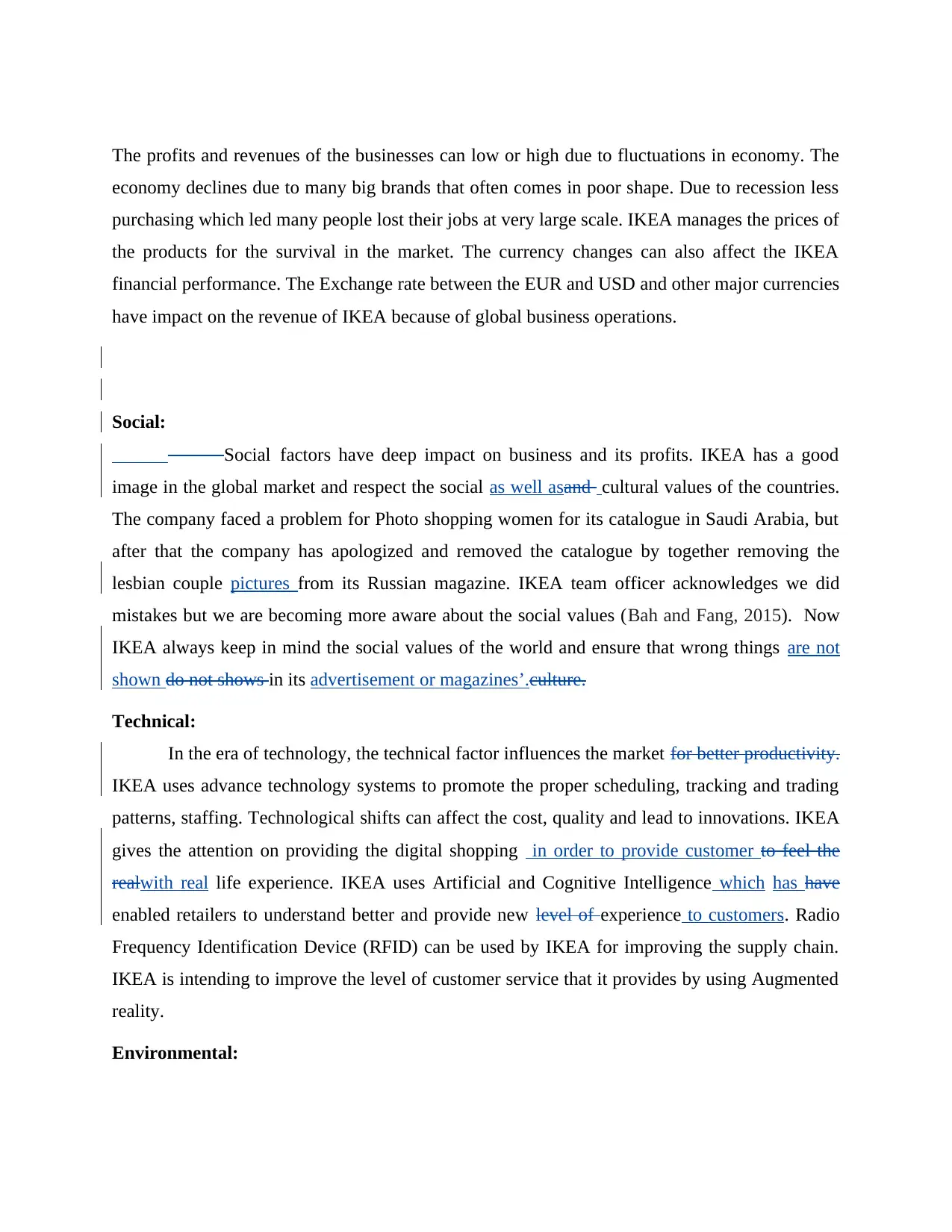
The profits and revenues of the businesses can low or high due to fluctuations in economy. The
economy declines due to many big brands that often comes in poor shape. Due to recession less
purchasing which led many people lost their jobs at very large scale. IKEA manages the prices of
the products for the survival in the market. The currency changes can also affect the IKEA
financial performance. The Exchange rate between the EUR and USD and other major currencies
have impact on the revenue of IKEA because of global business operations.
Social:
Social factors have deep impact on business and its profits. IKEA has a good
image in the global market and respect the social as well asand cultural values of the countries.
The company faced a problem for Photo shopping women for its catalogue in Saudi Arabia, but
after that the company has apologized and removed the catalogue by together removing the
lesbian couple pictures from its Russian magazine. IKEA team officer acknowledges we did
mistakes but we are becoming more aware about the social values (Bah and Fang, 2015). Now
IKEA always keep in mind the social values of the world and ensure that wrong things are not
shown do not shows in its advertisement or magazines’.culture.
Technical:
In the era of technology, the technical factor influences the market for better productivity.
IKEA uses advance technology systems to promote the proper scheduling, tracking and trading
patterns, staffing. Technological shifts can affect the cost, quality and lead to innovations. IKEA
gives the attention on providing the digital shopping in order to provide customer to feel the
realwith real life experience. IKEA uses Artificial and Cognitive Intelligence which has have
enabled retailers to understand better and provide new level of experience to customers. Radio
Frequency Identification Device (RFID) can be used by IKEA for improving the supply chain.
IKEA is intending to improve the level of customer service that it provides by using Augmented
reality.
Environmental:
economy declines due to many big brands that often comes in poor shape. Due to recession less
purchasing which led many people lost their jobs at very large scale. IKEA manages the prices of
the products for the survival in the market. The currency changes can also affect the IKEA
financial performance. The Exchange rate between the EUR and USD and other major currencies
have impact on the revenue of IKEA because of global business operations.
Social:
Social factors have deep impact on business and its profits. IKEA has a good
image in the global market and respect the social as well asand cultural values of the countries.
The company faced a problem for Photo shopping women for its catalogue in Saudi Arabia, but
after that the company has apologized and removed the catalogue by together removing the
lesbian couple pictures from its Russian magazine. IKEA team officer acknowledges we did
mistakes but we are becoming more aware about the social values (Bah and Fang, 2015). Now
IKEA always keep in mind the social values of the world and ensure that wrong things are not
shown do not shows in its advertisement or magazines’.culture.
Technical:
In the era of technology, the technical factor influences the market for better productivity.
IKEA uses advance technology systems to promote the proper scheduling, tracking and trading
patterns, staffing. Technological shifts can affect the cost, quality and lead to innovations. IKEA
gives the attention on providing the digital shopping in order to provide customer to feel the
realwith real life experience. IKEA uses Artificial and Cognitive Intelligence which has have
enabled retailers to understand better and provide new level of experience to customers. Radio
Frequency Identification Device (RFID) can be used by IKEA for improving the supply chain.
IKEA is intending to improve the level of customer service that it provides by using Augmented
reality.
Environmental:
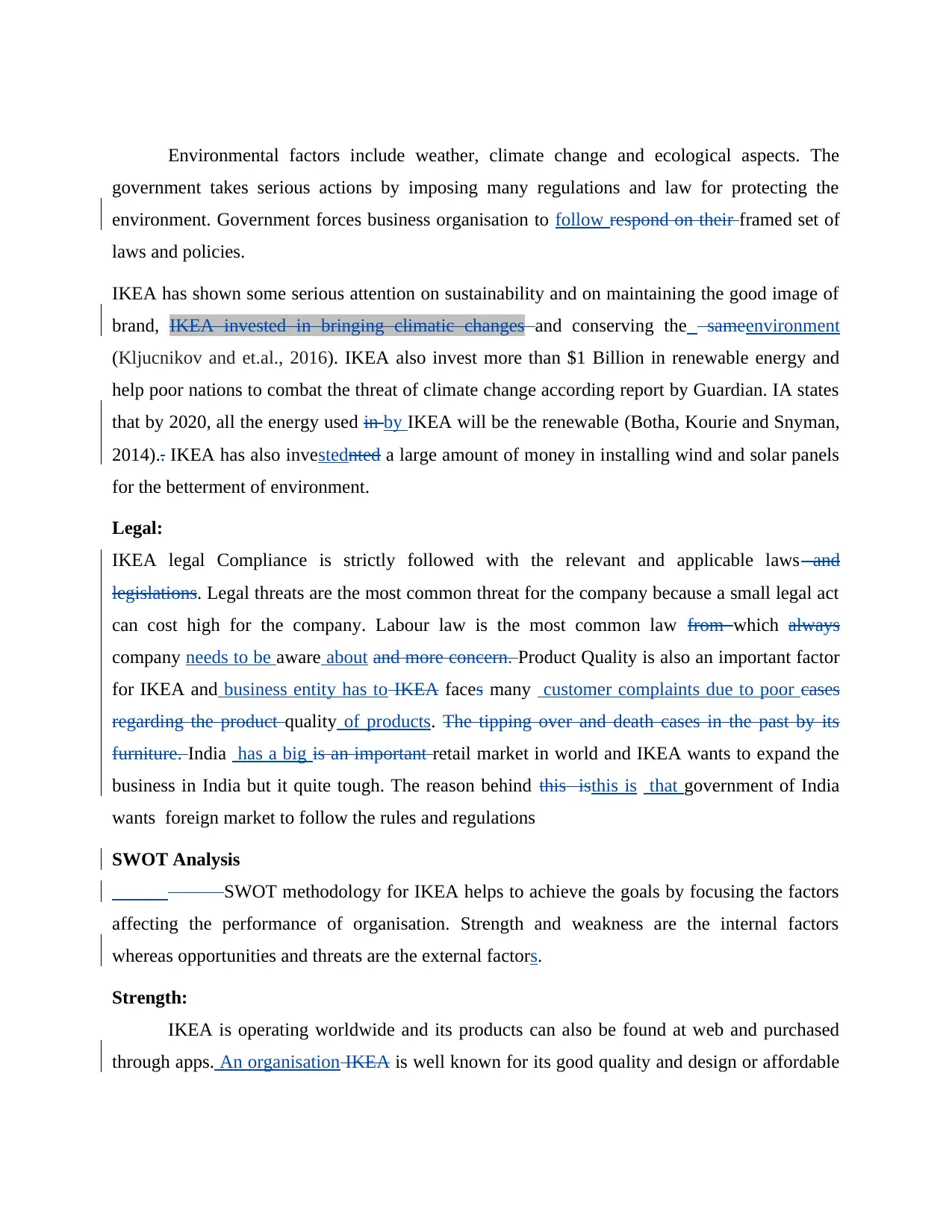
Environmental factors include weather, climate change and ecological aspects. The
government takes serious actions by imposing many regulations and law for protecting the
environment. Government forces business organisation to follow respond on their framed set of
laws and policies.
IKEA has shown some serious attention on sustainability and on maintaining the good image of
brand, IKEA invested in bringing climatic changes and conserving the sameenvironment
(Kljucnikov and et.al., 2016). IKEA also invest more than $1 Billion in renewable energy and
help poor nations to combat the threat of climate change according report by Guardian. IA states
that by 2020, all the energy used in by IKEA will be the renewable (Botha, Kourie and Snyman,
2014).. IKEA has also investednted a large amount of money in installing wind and solar panels
for the betterment of environment.
Legal:
IKEA legal Compliance is strictly followed with the relevant and applicable laws and
legislations. Legal threats are the most common threat for the company because a small legal act
can cost high for the company. Labour law is the most common law from which always
company needs to be aware about and more concern. Product Quality is also an important factor
for IKEA and business entity has to IKEA faces many customer complaints due to poor cases
regarding the product quality of products. The tipping over and death cases in the past by its
furniture. India has a big is an important retail market in world and IKEA wants to expand the
business in India but it quite tough. The reason behind this isthis is that government of India
wants foreign market to follow the rules and regulations
SWOT Analysis
SWOT methodology for IKEA helps to achieve the goals by focusing the factors
affecting the performance of organisation. Strength and weakness are the internal factors
whereas opportunities and threats are the external factors.
Strength:
IKEA is operating worldwide and its products can also be found at web and purchased
through apps. An organisation IKEA is well known for its good quality and design or affordable
government takes serious actions by imposing many regulations and law for protecting the
environment. Government forces business organisation to follow respond on their framed set of
laws and policies.
IKEA has shown some serious attention on sustainability and on maintaining the good image of
brand, IKEA invested in bringing climatic changes and conserving the sameenvironment
(Kljucnikov and et.al., 2016). IKEA also invest more than $1 Billion in renewable energy and
help poor nations to combat the threat of climate change according report by Guardian. IA states
that by 2020, all the energy used in by IKEA will be the renewable (Botha, Kourie and Snyman,
2014).. IKEA has also investednted a large amount of money in installing wind and solar panels
for the betterment of environment.
Legal:
IKEA legal Compliance is strictly followed with the relevant and applicable laws and
legislations. Legal threats are the most common threat for the company because a small legal act
can cost high for the company. Labour law is the most common law from which always
company needs to be aware about and more concern. Product Quality is also an important factor
for IKEA and business entity has to IKEA faces many customer complaints due to poor cases
regarding the product quality of products. The tipping over and death cases in the past by its
furniture. India has a big is an important retail market in world and IKEA wants to expand the
business in India but it quite tough. The reason behind this isthis is that government of India
wants foreign market to follow the rules and regulations
SWOT Analysis
SWOT methodology for IKEA helps to achieve the goals by focusing the factors
affecting the performance of organisation. Strength and weakness are the internal factors
whereas opportunities and threats are the external factors.
Strength:
IKEA is operating worldwide and its products can also be found at web and purchased
through apps. An organisation IKEA is well known for its good quality and design or affordable
⊘ This is a preview!⊘
Do you want full access?
Subscribe today to unlock all pages.

Trusted by 1+ million students worldwide
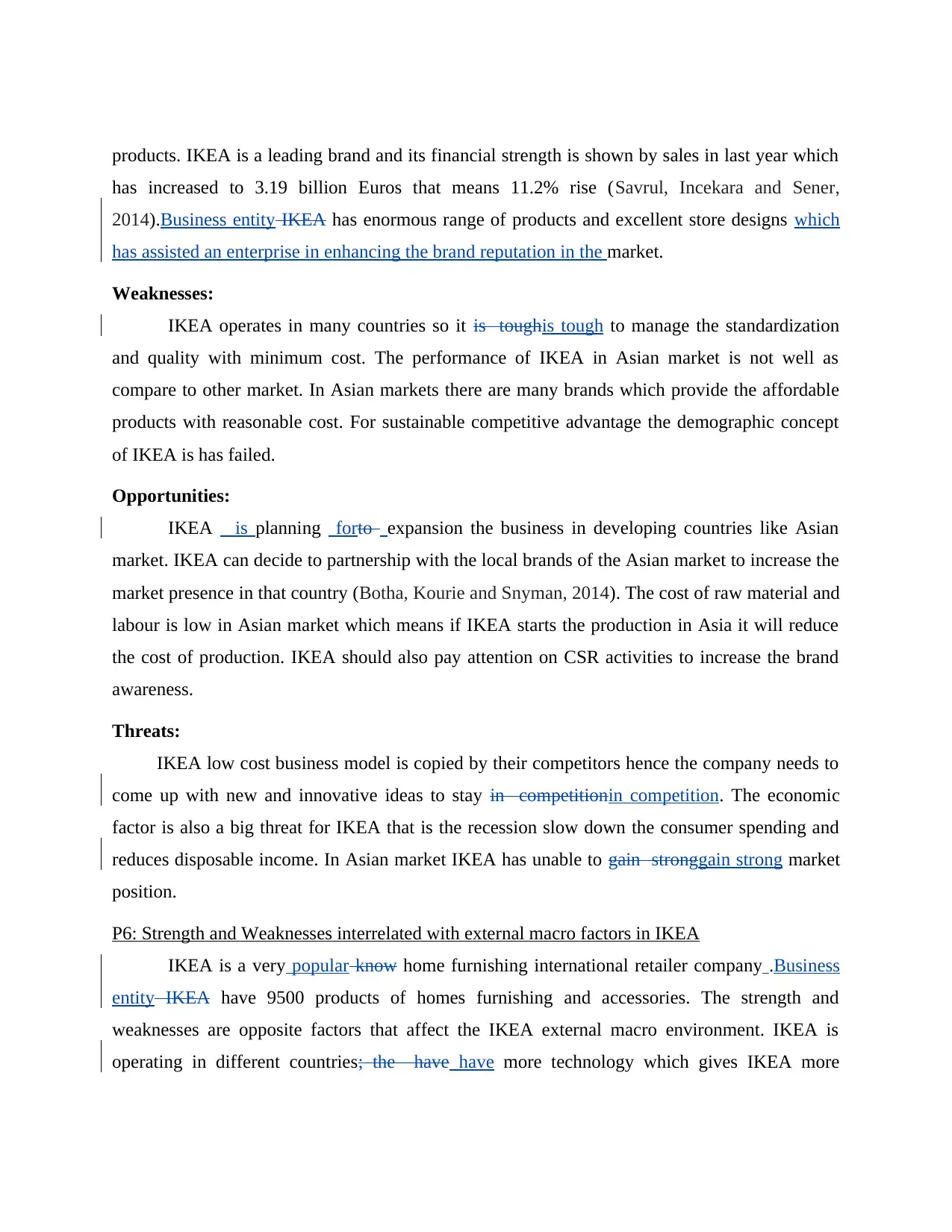
products. IKEA is a leading brand and its financial strength is shown by sales in last year which
has increased to 3.19 billion Euros that means 11.2% rise (Savrul, Incekara and Sener,
2014).Business entity IKEA has enormous range of products and excellent store designs which
has assisted an enterprise in enhancing the brand reputation in the market.
Weaknesses:
IKEA operates in many countries so it is toughis tough to manage the standardization
and quality with minimum cost. The performance of IKEA in Asian market is not well as
compare to other market. In Asian markets there are many brands which provide the affordable
products with reasonable cost. For sustainable competitive advantage the demographic concept
of IKEA is has failed.
Opportunities:
IKEA is planning forto expansion the business in developing countries like Asian
market. IKEA can decide to partnership with the local brands of the Asian market to increase the
market presence in that country (Botha, Kourie and Snyman, 2014). The cost of raw material and
labour is low in Asian market which means if IKEA starts the production in Asia it will reduce
the cost of production. IKEA should also pay attention on CSR activities to increase the brand
awareness.
Threats:
IKEA low cost business model is copied by their competitors hence the company needs to
come up with new and innovative ideas to stay in competitionin competition. The economic
factor is also a big threat for IKEA that is the recession slow down the consumer spending and
reduces disposable income. In Asian market IKEA has unable to gain stronggain strong market
position.
P6: Strength and Weaknesses interrelated with external macro factors in IKEA
IKEA is a very popular know home furnishing international retailer company .Business
entity IKEA have 9500 products of homes furnishing and accessories. The strength and
weaknesses are opposite factors that affect the IKEA external macro environment. IKEA is
operating in different countries; the have have more technology which gives IKEA more
has increased to 3.19 billion Euros that means 11.2% rise (Savrul, Incekara and Sener,
2014).Business entity IKEA has enormous range of products and excellent store designs which
has assisted an enterprise in enhancing the brand reputation in the market.
Weaknesses:
IKEA operates in many countries so it is toughis tough to manage the standardization
and quality with minimum cost. The performance of IKEA in Asian market is not well as
compare to other market. In Asian markets there are many brands which provide the affordable
products with reasonable cost. For sustainable competitive advantage the demographic concept
of IKEA is has failed.
Opportunities:
IKEA is planning forto expansion the business in developing countries like Asian
market. IKEA can decide to partnership with the local brands of the Asian market to increase the
market presence in that country (Botha, Kourie and Snyman, 2014). The cost of raw material and
labour is low in Asian market which means if IKEA starts the production in Asia it will reduce
the cost of production. IKEA should also pay attention on CSR activities to increase the brand
awareness.
Threats:
IKEA low cost business model is copied by their competitors hence the company needs to
come up with new and innovative ideas to stay in competitionin competition. The economic
factor is also a big threat for IKEA that is the recession slow down the consumer spending and
reduces disposable income. In Asian market IKEA has unable to gain stronggain strong market
position.
P6: Strength and Weaknesses interrelated with external macro factors in IKEA
IKEA is a very popular know home furnishing international retailer company .Business
entity IKEA have 9500 products of homes furnishing and accessories. The strength and
weaknesses are opposite factors that affect the IKEA external macro environment. IKEA is
operating in different countries; the have have more technology which gives IKEA more
Paraphrase This Document
Need a fresh take? Get an instant paraphrase of this document with our AI Paraphraser

platforms for operating the business at different level. IKEA products can be purchased through
apps globally. The technology helps to grow the company by cost and its profit. Due to social
and culture changes IKEA also changes the work perceptions. IKEA keep in mind the cultural
social values and provide the products according to the requirement of customers.
IKEA has high market weak marketshare in Asian countries like India which is important in
retail market. An organisationIKEA wants to expand the business in India but it is more tough
due to strictthe government policies of India (Prajogo, 2016). The Foreign investors or
organisation has to follow the laws and legislations set by the government. One of the strength of
IKEA is a big brand name for which IKEA also try to maintain the image internationally. IKEA
always do investment for helping the government IKEA invest $1 billion or more for renewable
energy programme. To help poor nation to cope up the climatic condition. By launching
“greenhouse model” by the company customers are more eagerly like to buy the product that are
conscious about environment. Due to the Environmental concerns in IKEA operations, Company
faces many challenges in sharing the environmental policies to customers, stakeholders. The
weakness of IKEA has to deliveredthedelivered the product global range for this the difference in
quality of product may vary. For this many legal cases are registered against the company such
as death cases for poor quality of products. Such types of incidents are this impacting the
performance and future growth of the IKEA. The economic factors may affect the business of
IKEA in weakness and strength. The recession can slow down the market as well the good
economy affects the IKEA by increases productivity and sales.
Expansion of business into developing economies opens many opportunities for IKEA to
increase the growth rate of the company (Bah and Fang, 2015). As the retail market grew 5%
IKEA emerging the market in developing economies. IKEA has better opportunities opportunists
to expand the business in Brazil, Mexico, Indonesia and Malaysia to sustain the future growth.
IKEA uses the raw material in a smarter way that made a strength of the company as well taking
care of environment by using Recycled and reclaimed waste products.
The social change in the environment and IKEA has respond to this changes by building the
online guide for customers which supports the customers with ideas and tips on its website. This
apps globally. The technology helps to grow the company by cost and its profit. Due to social
and culture changes IKEA also changes the work perceptions. IKEA keep in mind the cultural
social values and provide the products according to the requirement of customers.
IKEA has high market weak marketshare in Asian countries like India which is important in
retail market. An organisationIKEA wants to expand the business in India but it is more tough
due to strictthe government policies of India (Prajogo, 2016). The Foreign investors or
organisation has to follow the laws and legislations set by the government. One of the strength of
IKEA is a big brand name for which IKEA also try to maintain the image internationally. IKEA
always do investment for helping the government IKEA invest $1 billion or more for renewable
energy programme. To help poor nation to cope up the climatic condition. By launching
“greenhouse model” by the company customers are more eagerly like to buy the product that are
conscious about environment. Due to the Environmental concerns in IKEA operations, Company
faces many challenges in sharing the environmental policies to customers, stakeholders. The
weakness of IKEA has to deliveredthedelivered the product global range for this the difference in
quality of product may vary. For this many legal cases are registered against the company such
as death cases for poor quality of products. Such types of incidents are this impacting the
performance and future growth of the IKEA. The economic factors may affect the business of
IKEA in weakness and strength. The recession can slow down the market as well the good
economy affects the IKEA by increases productivity and sales.
Expansion of business into developing economies opens many opportunities for IKEA to
increase the growth rate of the company (Bah and Fang, 2015). As the retail market grew 5%
IKEA emerging the market in developing economies. IKEA has better opportunities opportunists
to expand the business in Brazil, Mexico, Indonesia and Malaysia to sustain the future growth.
IKEA uses the raw material in a smarter way that made a strength of the company as well taking
care of environment by using Recycled and reclaimed waste products.
The social change in the environment and IKEA has respond to this changes by building the
online guide for customers which supports the customers with ideas and tips on its website. This
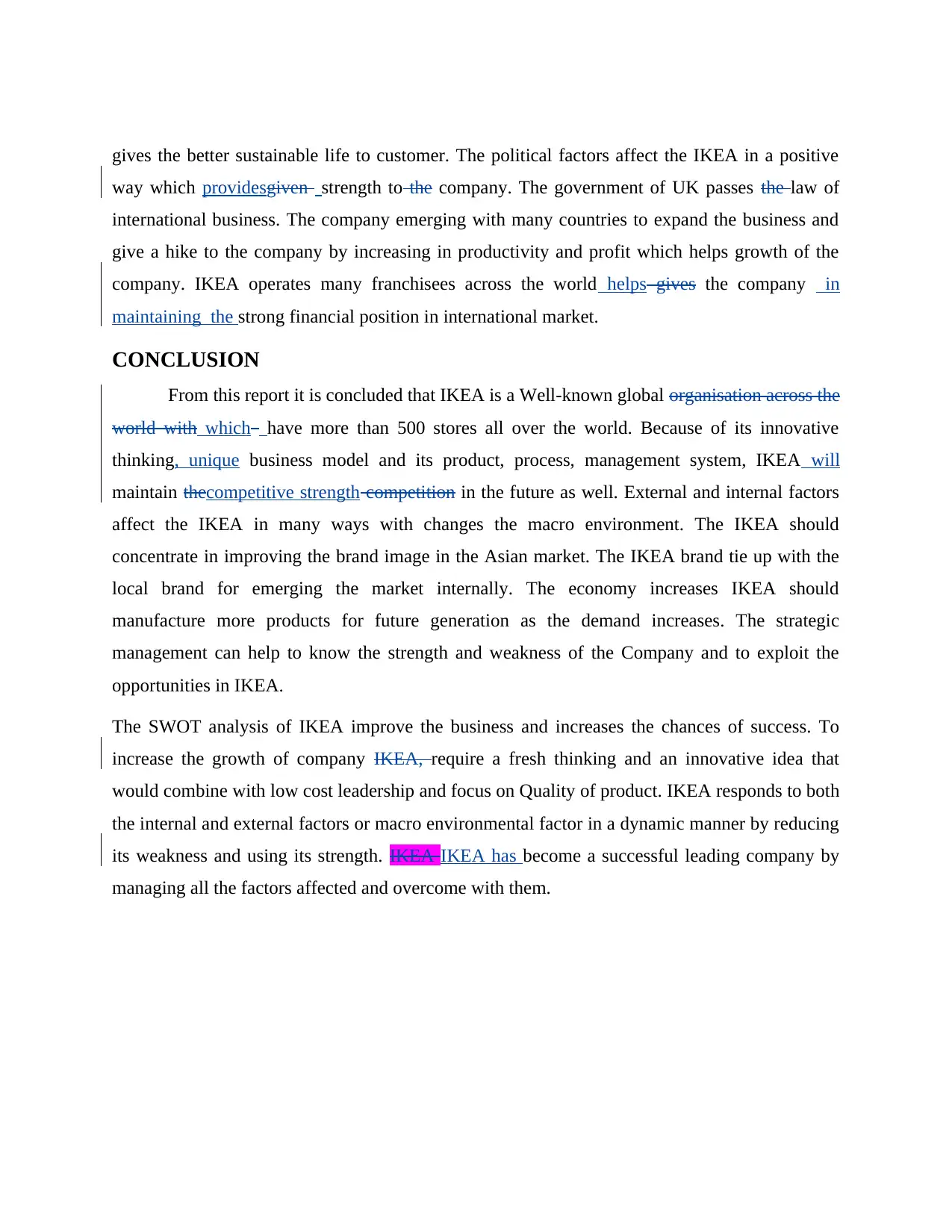
gives the better sustainable life to customer. The political factors affect the IKEA in a positive
way which providesgiven strength to the company. The government of UK passes the law of
international business. The company emerging with many countries to expand the business and
give a hike to the company by increasing in productivity and profit which helps growth of the
company. IKEA operates many franchisees across the world helps gives the company in
maintaining the strong financial position in international market.
CONCLUSION
From this report it is concluded that IKEA is a Well-known global organisation across the
world with which have more than 500 stores all over the world. Because of its innovative
thinking, unique business model and its product, process, management system, IKEA will
maintain thecompetitive strength competition in the future as well. External and internal factors
affect the IKEA in many ways with changes the macro environment. The IKEA should
concentrate in improving the brand image in the Asian market. The IKEA brand tie up with the
local brand for emerging the market internally. The economy increases IKEA should
manufacture more products for future generation as the demand increases. The strategic
management can help to know the strength and weakness of the Company and to exploit the
opportunities in IKEA.
The SWOT analysis of IKEA improve the business and increases the chances of success. To
increase the growth of company IKEA, require a fresh thinking and an innovative idea that
would combine with low cost leadership and focus on Quality of product. IKEA responds to both
the internal and external factors or macro environmental factor in a dynamic manner by reducing
its weakness and using its strength. IKEA IKEA has become a successful leading company by
managing all the factors affected and overcome with them.
way which providesgiven strength to the company. The government of UK passes the law of
international business. The company emerging with many countries to expand the business and
give a hike to the company by increasing in productivity and profit which helps growth of the
company. IKEA operates many franchisees across the world helps gives the company in
maintaining the strong financial position in international market.
CONCLUSION
From this report it is concluded that IKEA is a Well-known global organisation across the
world with which have more than 500 stores all over the world. Because of its innovative
thinking, unique business model and its product, process, management system, IKEA will
maintain thecompetitive strength competition in the future as well. External and internal factors
affect the IKEA in many ways with changes the macro environment. The IKEA should
concentrate in improving the brand image in the Asian market. The IKEA brand tie up with the
local brand for emerging the market internally. The economy increases IKEA should
manufacture more products for future generation as the demand increases. The strategic
management can help to know the strength and weakness of the Company and to exploit the
opportunities in IKEA.
The SWOT analysis of IKEA improve the business and increases the chances of success. To
increase the growth of company IKEA, require a fresh thinking and an innovative idea that
would combine with low cost leadership and focus on Quality of product. IKEA responds to both
the internal and external factors or macro environmental factor in a dynamic manner by reducing
its weakness and using its strength. IKEA IKEA has become a successful leading company by
managing all the factors affected and overcome with them.
⊘ This is a preview!⊘
Do you want full access?
Subscribe today to unlock all pages.

Trusted by 1+ million students worldwide

REFERENCES
Books and Journals
Bah, E.H. and Fang, L., 2015. Impact of the business environment on output and productivity
in Africa. Journal of Development Economics. 114. pp.159-171.
Botha, A., Kourie, D. and Snyman, R., 2014. Coping with continuous change in the business
environment: Knowledge management and knowledge management technology. Elsevier.
Kljucnikov, A., and et.al., 2016. The entreprenurialentrepreneurial perception of SME business
environment quality in the Czech Republic. Journal of Competitiveness. 8(1).
Prajogo, D.I., 2016. The strategic fit between innovation strategies and business environment in
delivering business performance. International Journal of Production Economics.171.
pp.241-249.
Savrul, M., Incekara, A. and Sener, S., 2014. The potential of e-commerce for SMEs in a
globalizing business environment. Procedia-Social and BehavioralBehavioural Sciences.
150. pp.35-45.
Online
IKEA SWOT ANALYSIS 2016. 2016. Abhijeet Pratap [Online]. AccesseedAccessed through:
<https://www.cheshnotes.com/2016/09/ikea-swot-analysis-2016/>
IKEA SWOT & PESTLE Analysis. 2018. [Online]. AccesseedAccessed through:
<https://www.swotandpestle.com/ikea/>
Books and Journals
Bah, E.H. and Fang, L., 2015. Impact of the business environment on output and productivity
in Africa. Journal of Development Economics. 114. pp.159-171.
Botha, A., Kourie, D. and Snyman, R., 2014. Coping with continuous change in the business
environment: Knowledge management and knowledge management technology. Elsevier.
Kljucnikov, A., and et.al., 2016. The entreprenurialentrepreneurial perception of SME business
environment quality in the Czech Republic. Journal of Competitiveness. 8(1).
Prajogo, D.I., 2016. The strategic fit between innovation strategies and business environment in
delivering business performance. International Journal of Production Economics.171.
pp.241-249.
Savrul, M., Incekara, A. and Sener, S., 2014. The potential of e-commerce for SMEs in a
globalizing business environment. Procedia-Social and BehavioralBehavioural Sciences.
150. pp.35-45.
Online
IKEA SWOT ANALYSIS 2016. 2016. Abhijeet Pratap [Online]. AccesseedAccessed through:
<https://www.cheshnotes.com/2016/09/ikea-swot-analysis-2016/>
IKEA SWOT & PESTLE Analysis. 2018. [Online]. AccesseedAccessed through:
<https://www.swotandpestle.com/ikea/>
1 out of 10
Related Documents
Your All-in-One AI-Powered Toolkit for Academic Success.
+13062052269
info@desklib.com
Available 24*7 on WhatsApp / Email
![[object Object]](/_next/static/media/star-bottom.7253800d.svg)
Unlock your academic potential
Copyright © 2020–2025 A2Z Services. All Rights Reserved. Developed and managed by ZUCOL.





